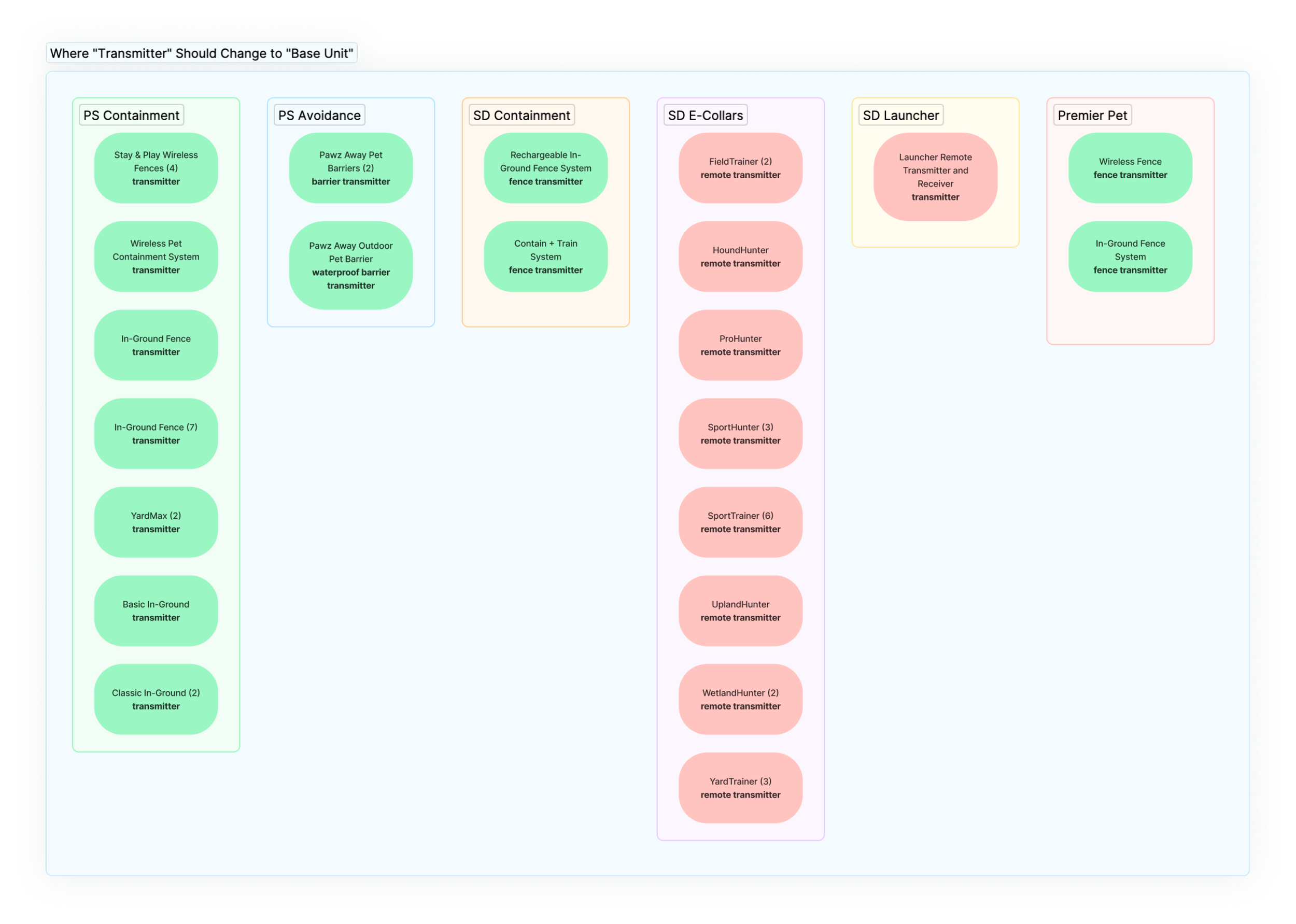UX Design Project - PetSafe Brands
Increasing user understanding and accessibility by simplifying terminology
Imagine you are the lead user experience designer working at a company that is an established leader in the pet containment and pet tech industry.
Your company is hoping to expand its suite of connected pet products to increase its customer base and revenue.
To quickly fill the gap in the connected containment field, you and the project team are working to take an existing containment system and add connectivity features.
You’re transitioning from a supportive role to a lead UX role on this project. Throughout your work on this project, you’ve noticed usability testing participants struggle to understand technical terminology used in the setup experience.
The terms are literal, engineering terms the team understands internally but are not accessible to users. The confusion created by the terminology is contributing to mistakes being made during the setup of the product potentially threatening the safety of the pet.
The Problem
What I Did
-

Identified the Problem
I heard participants struggle with certain technical terms we were using during product usability testing.
-

Ideated on Solutions
I came up with alternatives for the confusing terms and tested them during iterations of product usability testing.
-

Recommended New Terms
Once I felt confident in the alternative terms, I recommended the change to product stakeholders.
Key Project Takeaway
Observing this potential for improvement early on in the project allowed me to ideate on alternative solutions, test the suggestions, strategize a plan for change, and share the recommendations with stakeholders resulting in thoughtful conversation rather than a quick, reactive decision.
-
Challenges
• Communicating the need for the changes based on observational learnings when stakeholders wanted numbers and statistics to feel comfortable deciding to change.
• Managing stakeholder thoughts and feelings to avoid immediate rejection of my suggestions.
• Working outside the typical process since our team usually does not have time to identify these improvements early on when change can more easily happen.
-
Learnings
• Communicating early and often so key stakeholders are aware of progress and learnings helped suggested changes be more easily received.
• Clearly documenting content observations during testing reports helped prove the need for change.
• Including key stakeholders in ideation sessions around potential solutions helped them feel more invested and open to making changes.
Discovery Stage
While conducting a usability test of the setup experience for a connected wireless fence, I heard participants struggle with several technical terms we were using to explain parts of the setup process.
Terminology Issues
Historically, product terminology was defined by the engineers working on the product resulting in literal, technical terms.
Participants struggled with several of these technical terms that added unnecessary cognitive load. The terms everyone struggled with were:
transmitter
radius
receiver
Documenting the Problem
Although the focus of testing was on evaluating the changes my team and I made to improve the setup experience, we discovered we were not talking to the user in terms they could easily understand. After it became clear this was a common issue, I included the issue in our research objectives to evaluate.




Participants confused “radius” with “diameter” or “circumference.”
Participants were confused when trying to understand what “transmitter” or “receiver” meant or what part of the product those terms were referring to.
Key Takeaways
Ideation Stage
After identifying the issue and observing how the technical terminology impacted the user experience, I ideated on more user-friendly term options.
Researching Options
I researched industry-standard terms that would be applicable alternatives to the term “transmitter.” After exploring different variations, I felt “base unit” was the best alternative.
I also suggested we use the term “distance” to replace “radius” as the term worked from a literal standpoint but also technically was correct.
The team and I agreed simplifying “receiver” and “receiver collar” to “collar” was the best option and aligned with the other changes. I then ran our suggested updates by content team members as a quick gut check.
Testing the Updates
After coming up with more user-friendly alternatives, I needed to validate that the new term options removed complexity and cognitive load. I evaluated the changes in the next round of planned usability testing.




Key Takeaways
Participants easily understood the term “distance” even though they struggled with the concept of the boundary being circular.
Participants easily understood what “base unit” was referring to.
Evaluating the Impact
After validating the suggested changes, I researched all products we currently used the term “transmitter” with, documented which products we would recommend changing the term, and evaluated potential future products that might be impacted to understand the potential impact and create a change management plan.
Handoff Stage
Once confident in the suggestions and evaluation of the impact, I was ready to communicate our findings and recommendations to project stakeholders.
Presenting the Plan
I prepared a presentation summarizing at a high level my reasoning, recommendations, and product research for discussion with project stakeholders.
I shared my presentation and plan with stakeholders and was met with some resistance due to consistency concerns with our products already on the market.
After more conversations, meetings, and discussions, I convinced stakeholders of the easy wins we could make for the customer by changing the terminology in our future products with systems that worked like the transmitter.






















